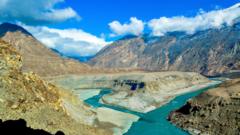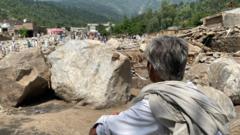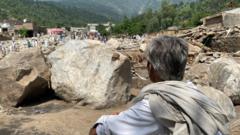India's recent suspension of the Indus Waters Treaty raises concerns about its ability to control river flows towards Pakistan amidst claims of cross-border terrorism. Experts analyze the practical implications of such actions, exploring infrastructure limitations and the balance of power over shared water resources.
India's Water Diplomacy at a Crossroads: Strategic Implications of the Indus Waters Treaty Suspension

India's Water Diplomacy at a Crossroads: Strategic Implications of the Indus Waters Treaty Suspension
As India suspends the 1960 Indus Waters Treaty amid rising tensions with Pakistan, experts question the feasibility of restricting river flows and the potential repercussions for regional stability.
The Indus River, a critical lifeline for both India and Pakistan, has become the center of heightened geopolitical tensions following India's suspension of the Indus Waters Treaty (IWT) enacted in 1960. This landmark treaty, established to manage the water resources of the Indus River basin effectively, has weathered two wars between the nuclear neighbors. Still, its future now hangs in the balance as India reacts to security concerns stemming from a recent attack in Indian-administered Kashmir.
India has taken various measures against Pakistan, accusing it of supporting terrorism—a claim that Pakistan vehemently denies. The IWT allocates the Ravi, Beas, and Sutlej rivers to India while allowing Pakistan control over the Indus, Chenab, and Jhelum rivers. While disputes over water management have previously arisen, this is unprecedented as India has announced a treaty suspension, leveraging its geographical position as the upstream country.
But can India genuinely halt the flow of the Indus and its tributaries? Experts indicate the answer is complex. Geographical and infrastructural limitations hinder India's capacity to manage the substantial water flow from the western rivers during peak times. The current water structures predominantly function as run-of-the-river hydropower plants, lacking the necessary storage facilities to significantly divert or hold back large water volumes.
Historically, tensions surrounding water management have led both nations to engage in legal disputes. Nonetheless, experts are skeptical if India could effectively modify its infrastructure to reduce river flow without repercussions. While the country might now have more autonomy regarding water project information—such as not sharing data with Pakistan— it faces internal challenges regarding infrastructure development and maintenance.
As India's infrastructure progresses slowly, many highlight that control over water may affect Pakistan predominantly during dry seasons when resources are scant. The absence of treaty constraints could raise concerns about water security in the region, with the potential for India to "weaponize" water.
Moreover, the risks associated with water mismanagement could affect India itself, as the dams located far from the border could lead to significant flooding in Indian territory if misused. A potential strategy for India may involve aggressive flushing of silt from its reservoirs, which, although mitigates silting issues, could pose downstream threats to Pakistan's water infrastructure.
This unfolding saga over shared water resources not only underscores the fragility of diplomacy in South Asia but also highlights the interconnectedness of regional water politics. As the situation develops, the global implications of India's strategic water policies in the Indus River basin will be watched closely, especially against the backdrop of China’s expanding influence in the region.


















